The African plains are home to some of the planet’s most iconic creatures, but few capture the imagination quite like the zebra. With their striking black and white stripes, these equids are more than just beautiful animals; they are a marvel of evolution, social complexity, and ecological importance. From their mysterious patterns to their vital role in the savanna ecosystem, zebras offer a captivating glimpse into the wild heart of Africa.

Unraveling the Stripes: An Introduction to Zebras
Zebras are members of the horse family, Equidae, instantly recognizable by their bold, contrasting stripes. These patterns are unique to each individual, much like human fingerprints, making every zebra a walking masterpiece. Found exclusively in Africa, these magnificent animals are central figures in the continent’s diverse wildlife tapestry.
Where Zebras Roam: Habitats and Distribution
Zebras are adaptable creatures, thriving in a variety of African landscapes. Their primary habitats include grasslands, savannas, woodlands, and even mountainous regions. Their distribution spans across eastern and southern Africa, with specific species occupying different geographical ranges.
- Plains Zebras (Equus quagga): The most widespread species, found from South Sudan and Ethiopia down to South Africa. They prefer treeless grasslands and savannas.
- Mountain Zebras (Equus zebra): Inhabit the mountainous and hilly regions of Namibia, Angola, and South Africa, adapted to rugged terrain.
- Grévy’s Zebras (Equus grevyi): The largest and most endangered species, restricted to the semi-arid grasslands and shrublands of Kenya and Ethiopia.
Access to water is a critical factor for zebra survival, influencing their movements and grazing patterns, especially during dry seasons. They are often found near permanent water sources, making riverbanks and waterholes vital gathering points.
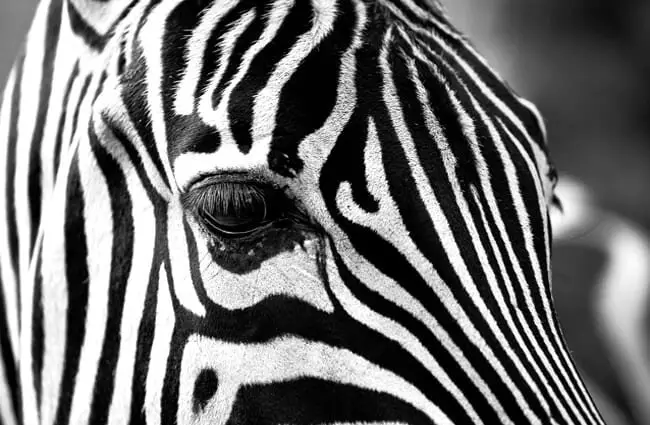
A Grazer’s Delight: The Zebra Diet
Zebras are herbivores, primarily grazers that feed on a wide array of grasses. Their digestive systems are less efficient than those of ruminants like wildebeest, meaning they need to consume larger quantities of lower-quality forage. This dietary strategy allows them to coexist with other grazers, as zebras can process tough, fibrous grasses that other animals might bypass.
- Primary Food Source: Various types of grasses, including red oat grass, star grass, and Bermuda grass.
- Supplemental Forage: In times of scarcity, they may browse on leaves, bark, and shoots from shrubs and trees.
Their ability to digest coarse vegetation plays a crucial role in the ecosystem, preparing the way for more selective grazers by reducing the bulk of tough plant material.
Family Ties and Herd Dynamics: Zebra Social Life
Zebra social structures vary by species, but all are highly social animals. Plains zebras live in stable family units called harems, consisting of a single stallion, several mares, and their offspring. These harems are remarkably stable, often lasting for years. Bachelor males form separate groups, vying for control of harems.
Grévy’s zebras, in contrast, have a more fluid social system. Stallions establish large territories that they defend, and mares and their young move freely between these territories, often associating in temporary groups. Mountain zebras form smaller, stable family groups similar to plains zebras.
Within these groups, zebras communicate through a variety of vocalizations, including barks, snorts, and whinnies. Body language, such as ear position and tail flicks, also conveys important messages about mood and intent.
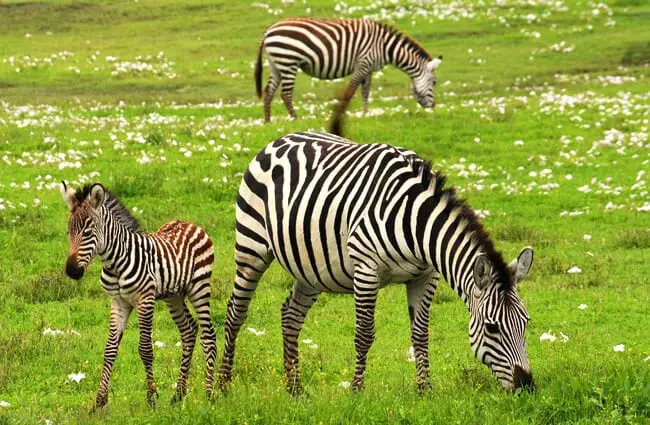
Fascinating Facts About Zebras
The world of zebras is full of intriguing details:
- Stripe Uniqueness: No two zebras have identical stripe patterns. This makes individual identification possible for researchers and for zebras themselves.
- Are They Black with White Stripes or White with Black Stripes?: Scientific consensus leans towards zebras being black animals with white stripes. Their skin underneath the fur is black.
- Predator Confusion: The stripes are thought to confuse predators, especially when zebras are in a herd. The mass of moving stripes makes it difficult for a predator to single out an individual.
- Thermoregulation: Another theory suggests stripes help with thermoregulation, creating convection currents that cool the zebra’s body.
- Fly Repellent: Recent research indicates stripes may deter biting flies, which are less attracted to striped surfaces.
- Sleeping Habits: Zebras can sleep standing up, but they also lie down for deeper sleep, usually with other zebras standing guard.
- Speed Demons: Zebras can run at speeds up to 40 miles per hour (65 km/h) to escape predators.
A Deeper Dive: Zebra Biology and Ecology
For the aspiring zoologist or dedicated animal enthusiast, understanding the intricacies of zebra biology and their ecological role provides a richer appreciation for these striped wonders.
Evolutionary Journey: The Ancestry of Zebras
Zebras belong to the genus Equus, which also includes horses and donkeys. Their evolutionary history traces back millions of years, with fossil evidence suggesting their ancestors originated in North America before migrating to Asia and then Africa. The distinct zebra lineages diverged within Africa, adapting to various environments.
The most famous extinct zebra relative is the Quagga, a subspecies of the Plains Zebra that had stripes only on its head, neck, and front part of its body, fading to a plain brown rear. It was hunted to extinction in the late 19th century, a stark reminder of human impact on wildlife. Efforts are currently underway to selectively breed plains zebras to resemble the Quagga, a project known as the Quagga Project, aiming to bring back a similar phenotype.
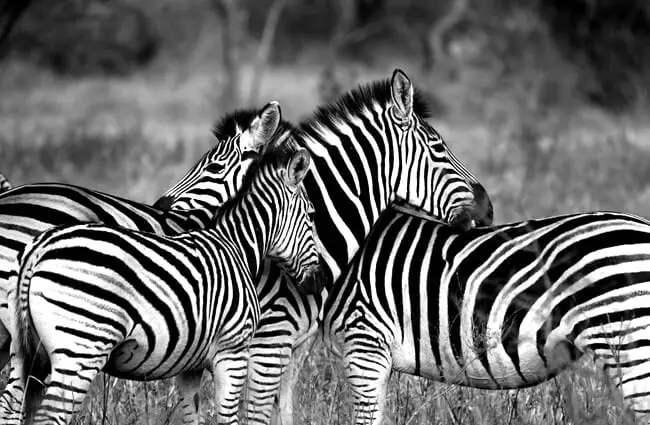
Physical Adaptations and the Stripe Mystery
Beyond their iconic stripes, zebras possess several physical adaptations crucial for survival in the African wilderness:
- Strong Legs and Hooves: Built for speed and endurance, allowing them to cover vast distances and outrun predators.
- Excellent Senses: Keen eyesight, hearing, and smell help them detect predators and find food and water. Their eyes are positioned on the sides of their heads, providing a wide field of vision.
- Dental Structure: Specialized teeth for grinding tough grasses, including large incisors for cropping and strong molars for chewing.
The exact function of zebra stripes remains a subject of scientific debate, with multiple theories gaining traction:
- Camouflage: While seemingly conspicuous, stripes might provide camouflage in certain light conditions, especially at dawn and dusk, breaking up the zebra’s outline against the dappled light of the savanna.
- Social Recognition: The unique patterns could aid in individual recognition within a herd, crucial for social bonding and identifying family members.
- Predator Dazzle: The “dazzle camouflage” theory suggests that when a herd of zebras runs, the stripes create an optical illusion, making it difficult for predators like lions to focus on a single individual.
- Insect Repellent: Studies have shown that biting flies, such as tsetse flies and horseflies, are less likely to land on striped surfaces than on solid colored ones. This could be a significant advantage in areas where these insects transmit diseases.
- Thermoregulation: The differential absorption of sunlight by black and white stripes may create small convection currents that help cool the zebra’s body, particularly in the intense African heat.
Reproduction and Life Cycle
Zebra reproduction is a fascinating process, vital for herd continuity. Mares typically reach sexual maturity around 3-4 years of age, while stallions mature later, around 5-6 years, when they are strong enough to compete for harems.
- Mating Season: While breeding can occur year-round, there are often peaks during the rainy season when food is abundant.
- Gestation Period: A mare carries her foal for approximately 12-13 months.
- Birth: A single foal is usually born, weighing around 60-70 pounds (27-32 kg). Foals are precocial, meaning they are relatively mature and mobile at birth.
- Rapid Development: Within minutes of birth, a foal can stand, and within an hour, it can run, a crucial adaptation for escaping predators. The mare and foal form a strong bond, with the foal learning to recognize its mother’s unique stripe pattern and scent.
- Parental Care: Mares are highly protective of their young. The stallion of the harem also plays a role in protecting the family unit from threats and rival males.
- Lifespan: Zebras typically live for 20-30 years in the wild, and sometimes longer in captivity.
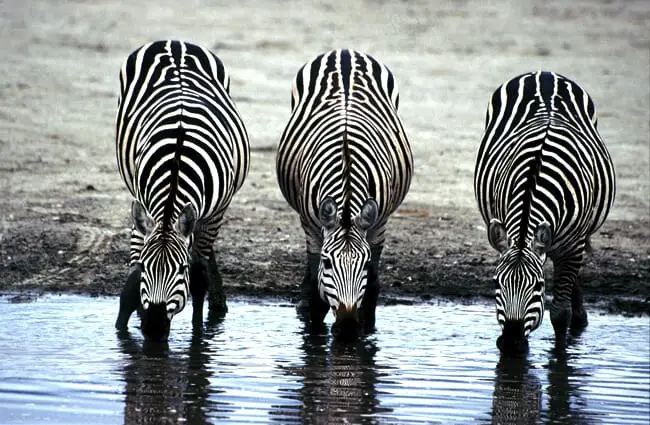
Ecosystem Contributions and Interactions
Zebras are integral components of the African savanna ecosystem, playing multiple roles:
- Primary Consumers: As grazers, they convert plant matter into energy, forming a crucial link in the food chain.
- Pioneer Grazers: Their ability to consume coarse grasses helps to open up grasslands, making them more suitable for other, more selective grazers like wildebeest and gazelles. This sequential grazing pattern maximizes resource utilization.
- Prey Species: Zebras are a primary food source for large carnivores such as lions, hyenas, cheetahs, and wild dogs. This predator-prey dynamic is essential for maintaining the health and balance of predator populations and for natural selection within zebra herds.
- Seed Dispersal: Through their droppings, zebras contribute to seed dispersal, helping to propagate plant species across the landscape.
- Waterhole Dynamics: Their need for water means they frequently visit waterholes, impacting local vegetation and creating pathways that other animals also use.
Zebras and Human Culture
Zebras have long captivated human imagination, appearing in art, literature, and folklore across various cultures. Their distinctive appearance makes them popular symbols of individuality, wildness, and beauty. In many African cultures, zebras are revered for their strength and unique patterns. They are a staple of wildlife documentaries, tourism, and conservation efforts, representing the majesty of African biodiversity.
Conservation Status and Human Interaction
The conservation status of zebras varies by species:
- Plains Zebra: Currently listed as Near Threatened, facing localized population declines due to habitat loss, poaching, and competition with livestock.
- Mountain Zebra: Listed as Vulnerable, with two subspecies, Cape Mountain Zebra and Hartmann’s Mountain Zebra, both having faced severe population bottlenecks but are now recovering thanks to dedicated conservation efforts.
- Grévy’s Zebra: Listed as Endangered, primarily threatened by habitat degradation, competition for water and grazing with livestock, and poaching.
Human interaction with zebras is complex. While tourism provides economic incentives for conservation, human encroachment on zebra habitats leads to conflict. Poaching for their meat and skins, though illegal, remains a threat in some areas. Conservation initiatives focus on protecting habitats, combating poaching, and promoting coexistence between humans and wildlife.
Practical Insights: Interacting with Zebras
Whether you are an aspiring zoologist, an animal lover planning a safari, a hiker in zebra territory, or a zookeeper, understanding how to interact with and care for these animals is paramount.
Finding Zebras in the Wild: A Safari Guide
For those hoping to witness zebras in their natural habitat, here is what to know:
- Best Locations:
- Plains Zebras: Abundant in national parks and reserves across East Africa (e.g., Maasai Mara, Serengeti, Kruger National Park) and Southern Africa.
- Mountain Zebras: Found in specific mountainous parks in South Africa (e.g., Mountain Zebra National Park) and Namibia.
- Grévy’s Zebras: Primarily found in northern Kenya (e.g., Samburu National Reserve) and parts of Ethiopia.
- Optimal Viewing Times: Zebras are active during the day, often grazing in the cooler morning and late afternoon hours. They gather at waterholes during the hotter parts of the day.
- How to Spot Them: Look for large herds grazing in open grasslands. Their stripes, while serving as camouflage, also make them quite visible against certain backdrops. Listen for their distinctive barks.
- Guided Safaris: The safest and most effective way to find zebras is through guided safari tours with experienced rangers who know their territories and behaviors.
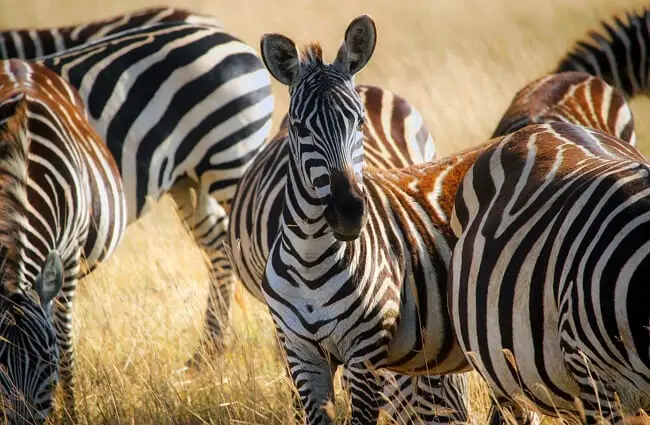
Encountering Zebras in the Wild: Safety for Hikers
While zebras are generally not aggressive towards humans, they are wild animals and should be treated with respect and caution. If you encounter zebras while hiking:
- Maintain Distance: Always keep a safe and respectful distance. Never approach a zebra, especially a mare with a foal.
- Observe, Do Not Disturb: Enjoy watching them from afar. Avoid making loud noises or sudden movements that could startle them.
- Never Feed Wild Animals: Feeding zebras can alter their natural behavior, make them dependent on humans, and potentially lead to aggression.
- Be Aware of Your Surroundings: Zebras are prey animals, and their presence might indicate the presence of predators. Stay vigilant.
- Do Not Block Escape Routes: If you are in a vehicle, ensure you do not block their path to water or grazing areas.
- If a Zebra Appears Aggressive: While rare, a zebra might flatten its ears, bare its teeth, or kick if it feels threatened. Slowly and calmly back away, avoiding direct eye contact.
Zookeeping: Caring for Zebras in Captivity
Caring for zebras in a zoological setting requires specialized knowledge and dedication to replicate their natural environment and social needs:
- Habitat Design:
- Spacious Enclosures: Zebras need ample space to run and graze, mimicking open grasslands.
- Substrate: Provide natural substrates like soil and grass, avoiding hard surfaces that can harm hooves.
- Shelter: Offer shaded areas and sturdy shelters to protect them from extreme weather.
- Water Features: Access to clean, fresh water for drinking is essential, often provided via troughs or naturalistic pools.
- Dietary Management:
- High-Fiber Diet: Primarily hay and specialized herbivore pellets, supplemented with fresh greens.
- Controlled Grazing: If possible, allow access to safe, managed grazing areas.
- Dental Care: Regular dental checks are crucial due to their grazing diet, which can lead to dental issues.
- Social Structure:
- Herd Living: Zebras are social animals, so they should be housed in groups, ideally reflecting natural harem or bachelor group dynamics.
- Introductions: Careful planning and slow introductions are necessary when bringing new individuals into a group to minimize aggression.
- Veterinary Care:
- Routine Health Checks: Regular examinations, vaccinations, and deworming.
- Hoof Care: Trimming and inspection to prevent lameness.
- Monitoring for Stress: Observing behavior for signs of stress, illness, or injury.
- Enrichment:
- Foraging Opportunities: Hiding food, using slow-feeder devices to encourage natural foraging behaviors.
- Environmental Enrichment: Providing varied terrain, rubbing posts, and opportunities for dust bathing.
- Social Interaction: Ensuring appropriate group dynamics and opportunities for interaction.
- What to Avoid:
- Isolation: Zebras should not be housed alone unless medically necessary.
- Overcrowding: Insufficient space can lead to stress and aggression.
- Inappropriate Diet: Avoid sugary treats or diets low in fiber, which can cause digestive problems.
- Sudden Changes: Introduce changes to diet, enclosure, or social groups gradually.
- Direct Human Contact: While zebras can be habituated, direct handling should be minimized and performed by trained professionals only, as they retain strong wild instincts and can be dangerous.
Conclusion: The Enduring Allure of the Striped Equid
From the vast plains to the rugged mountains, zebras stand as enduring symbols of Africa’s wild beauty. Their intricate stripes, complex social lives, and vital ecological roles paint a picture of an animal perfectly adapted to its environment. Understanding these magnificent creatures not only enriches our knowledge of the natural world but also underscores the importance of conservation efforts to ensure their stripes continue to grace the African landscape for generations to come. Whether you are a student delving into their evolutionary past or an adventurer seeking them in the wild, the zebra offers an endless source of wonder and inspiration.

![Red Angus Closeup of a beautiful Red Angus cowPhoto by: U.S. Department of Agriculture [pubic domain]https://creativecommons.org/licenses/by/2.0/](https://animals.net/wp-content/uploads/2020/03/Red-Angus-4-238x178.jpg)


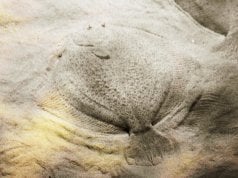

![Red Angus Closeup of a beautiful Red Angus cowPhoto by: U.S. Department of Agriculture [pubic domain]https://creativecommons.org/licenses/by/2.0/](https://animals.net/wp-content/uploads/2020/03/Red-Angus-4-100x75.jpg)

